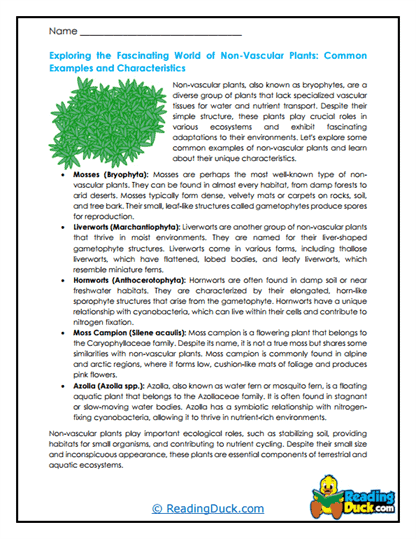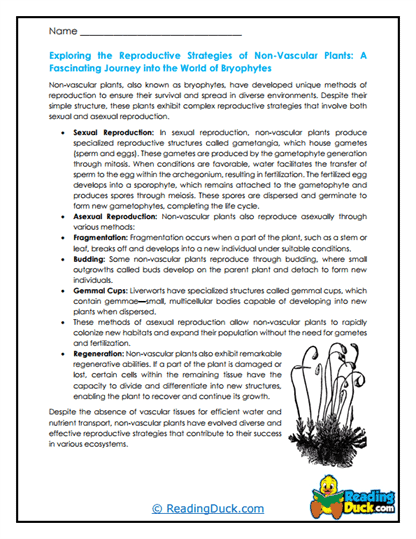Non-vascular Plants Worksheets
About Our Non-vascular Plants Worksheets
Our collection of Non-vascular Plants worksheets offers students an in-depth exploration of these fascinating organisms within the broader category of Biology and Plants. These worksheets are designed to engage students, helping them develop a solid understanding of non-vascular plants and their unique characteristics.
Each worksheet set includes:
- Multiple Choice Questions: These questions assess students' comprehension of the reading passage by asking them to select the correct answer from a set of options. This format helps reinforce key facts and concepts related to non-vascular plants.
- Short Answer Questions: In this section, students are required to write their own answers to questions based on the reading passage. This encourages them to recall and articulate information in their own words, promoting a deeper understanding of the material.
- Open-Ended Questions: These questions prompt students to provide personal input, opinions, or reflections related to the reading material. This allows students to connect the topic of non-vascular plants to their own experiences and thoughts.
Answer keys are provided for all question sheets, making it easy for teachers and parents to review and assess students' work. All worksheets are available as PDF files, which can be conveniently viewed electronically, downloaded, and printed for classroom or homeschool use.
Exploring Non-vascular Plants: Understanding Their Role in the Plant Kingdom
Non-vascular plants are a unique and essential group of plants that play a vital role in the Earth's ecosystems. Unlike vascular plants, which have specialized tissues for transporting water and nutrients, non-vascular plants lack these structures. Instead, they rely on simpler methods to survive and thrive in a variety of environments. When introducing students to the topic of non-vascular plants, it's important to highlight their simplicity, adaptability, and ecological significance.
What Are Non-vascular Plants?
Non-vascular plants are plants that do not have vascular tissues, such as xylem and phloem, which are responsible for transporting water, nutrients, and food throughout the plant. Because they lack these structures, non-vascular plants are generally small, low-growing, and thrive in moist environments where they can absorb water directly through their surfaces.
Types of Non-vascular Plants:
Non-vascular plants can be classified into three main groups, each with distinct characteristics and ecological roles:
- Bryophytes:
- Description: Bryophytes are the most well-known group of non-vascular plants. They include mosses, liverworts, and hornworts. These plants are typically small, green, and found in damp, shady areas. Bryophytes do not have true roots; instead, they anchor themselves to surfaces using structures called rhizoids.
- Examples:
- Mosses: Mosses are soft, green plants that often form dense mats on forest floors, rocks, and tree trunks. They play a crucial role in preventing soil erosion and retaining moisture in the environment.
- Liverworts: Liverworts are small, flat plants that resemble liver-shaped lobes, which is how they got their name. They are often found in moist, shaded environments and are important indicators of ecosystem health.
- Hornworts: Hornworts are named for their horn-like structures that protrude from the plant. These structures are actually spore-producing organs, and hornworts are commonly found in tropical and temperate regions.
- Algae:
- Description: While not traditionally classified as plants, algae are simple, non-vascular organisms that share many characteristics with non-vascular plants. Algae can be found in a variety of environments, including freshwater, marine, and terrestrial habitats. They are essential to the Earth's ecosystems as they produce a significant portion of the planet's oxygen and serve as the base of the food chain in aquatic environments.
- Examples:
- Green Algae: Green algae are the most plant-like of all algae, sharing a common ancestor with land plants. They are found in freshwater environments and are important for photosynthesis, producing oxygen and serving as food for aquatic organisms.
- Red Algae: Red algae are mostly found in marine environments and are known for their ability to survive in deep water due to their unique pigments that capture light at greater depths. Red algae are also used in various commercial products, such as agar and carrageenan, which are used in food processing.
- Fungi-like Non-vascular Plants:
- Description: Although fungi are not plants, some fungi-like organisms share characteristics with non-vascular plants. These organisms, such as lichens, are often found in similar environments and play important roles in ecosystems.
- Examples:
- Lichens: Lichens are symbiotic organisms composed of fungi and algae or cyanobacteria. They are incredibly resilient and can grow in harsh environments, such as on rocks, tree bark, and even in arctic tundras. Lichens contribute to soil formation and are important indicators of air quality.
How Non-vascular Plants Survive and Thrive
Non-vascular plants have adapted to their environments in unique ways:
- Absorption of Water and Nutrients:
- Direct Absorption: Non-vascular plants absorb water and nutrients directly through their surfaces, such as leaves and stems. This is why they are often found in moist environments where water is readily available. Their ability to absorb water directly allows them to survive in environments where vascular plants might struggle.
- Reproduction:
- Spore Production: Unlike vascular plants that reproduce using seeds, non-vascular plants reproduce via spores. Spores are lightweight, allowing them to be easily dispersed by wind or water. This method of reproduction is well-suited for the environments in which non-vascular plants live, ensuring their survival and spread.
- Asexual Reproduction: Many non-vascular plants can also reproduce asexually through fragmentation, where a part of the plant breaks off and grows into a new organism. This allows them to quickly colonize new areas.
- Adaptations to Environment:
- Tolerating Desiccation: Non-vascular plants have evolved to tolerate periods of drying out. Mosses, for example, can survive in a dormant state during dry conditions and quickly revive when water becomes available again.
- Forming Symbiotic Relationships: Some non-vascular plants, like lichens, form symbiotic relationships with other organisms, such as fungi. These relationships allow them to survive in extreme environments by combining the strengths of both partners.
Ecological Importance of Non-vascular Plants
Non-vascular plants play crucial roles in ecosystems, making them vital to the health of the planet:
- Soil Formation and Stabilization:
- Erosion Control: Mosses and other bryophytes help prevent soil erosion by stabilizing the ground with their rhizoids. They also contribute to the formation of soil by breaking down rocks and organic material.
- Water Retention: Non-vascular plants help retain moisture in the soil, creating a suitable environment for other plants and organisms to thrive. This is particularly important in forest ecosystems, where they contribute to the overall health of the habitat.
- Providing Habitat and Food:
- Supporting Biodiversity: Non-vascular plants provide habitat and food for a variety of organisms, including insects, small animals, and microorganisms. For example, mosses can support small invertebrates, while algae are a crucial food source in aquatic ecosystems.
- Serving as Indicators of Environmental Health: Because non-vascular plants are sensitive to changes in their environment, they serve as important indicators of ecosystem health. For example, the presence or absence of certain lichen species can indicate levels of air pollution.
- Contributing to the Carbon Cycle:
- Carbon Sequestration: Non-vascular plants, like algae, play a significant role in the global carbon cycle by capturing carbon dioxide through photosynthesis. This helps regulate the Earth's climate by reducing the amount of carbon dioxide in the atmosphere.
Using These Worksheets Effectively
Teachers and parents can use these Non-vascular Plants worksheets in various creative and effective ways to enhance student learning:
- Create a Moss Terrarium: After learning about mosses and other bryophytes, have students create their own moss terrarium. This hands-on project allows students to observe the growth and behavior of non-vascular plants in a controlled environment, reinforcing the concepts learned in the worksheets.
- Field Exploration and Observation: Organize a field trip or outdoor exploration where students can observe non-vascular plants in their natural habitats. Encourage them to take notes and compare their observations with what they’ve learned in the worksheets. This real-world experience helps solidify their understanding of the topic.
- Non-vascular Plant Research Project: Assign students a specific non-vascular plant or group of plants to research in more detail. They can use the information from the worksheets as a starting point, then present their findings to the class. This activity promotes independent learning and deepens their knowledge of non-vascular plants.
- Art and Science Integration: Have students create artwork inspired by non-vascular plants. They can draw or paint different species of mosses, liverworts, and algae, incorporating what they’ve learned about these plants' structures and habitats. This activity combines creativity with scientific learning, making the topic more engaging.
The Vital Role of Non-vascular Plants in Our World
Non-vascular plants, despite their small size and simple structures, play an essential role in maintaining the health and balance of ecosystems around the world. They contribute to soil formation, water retention, and carbon sequestration, making them vital players in the global carbon cycle. Additionally, non-vascular plants provide habitat and food for a wide range of organisms, supporting biodiversity and serving as indicators of environmental health. Understanding and appreciating these often-overlooked plants is crucial for recognizing their importance in the natural world and the broader context of ecological conservation.









